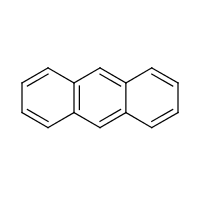Anthracene
Agent Name
Anthracene
CAS Number
120-12-7
Formula
C14-H10
Major Category
Other Classes

Synonyms
Anthracen [German]; Anthracin; Green Oil; Paranaphthalene; Tetra Olive N2G; [ChemIDplus]
Category
Polycyclic Aromatic Hydrocarbons
Description
Colorless or yellow solid with weak aromatic odor; [HSDB] Pure form is colorless with violet fluorescence; If impure, is yellow with green fluorescence; [Merck Index] Colorless or yellow crystalline solid; [MSDSonline]
Sources/Uses
Used to make dyestuffs (anthraquinone and alizarin dyes); Also used to make synthetic fibers and plastics and in semiconductor research; [HSDB] May be present in wood preservatives and pesticides; Occurs in coal tar volatiles, tobacco smoke, exhaust emissions, charcoal broiled meat smoke, edible oils, surface waters, waste waters, and lake sediments; [CHEMINFO]
Comments
A minor skin and respiratory tract irritant; [ICSC] Photosensitizing agent that may cause acute dermatitis; [HSDB] Minimal Risk Level (oral dose for 15-364 days) = 10 mg/kg/day (hepatic); [ATSDR] An irritant; May cause photosensitization; Effects in high-dose animal studies include fatty liver degeneration; [MSDSonline] See "POLYCYCLIC AROMATIC HYDROCARBONS."
Biomedical References
Exposure Assessment
Vapor Pressure
2.67E-06 mm Hg
Explanatory Notes
Flash point = 121 deg C; [ICSC]
NFPA
must be preheated
Adverse Effects
Hepatotoxin
Hepatoxic (a) from occupational exposure (secondary effect) or (b) in animal studies or in humans after ingestion
Dermatotoxin
PICD (photoirritant contact dermatitis)
IARC Carcinogen
Not classifiable
Diseases, Processes, and Activities Linked to This Agent
Diseases
Occupational diseases associated with exposure to this agent:
Processes
Industrial Processes with risk of exposure: